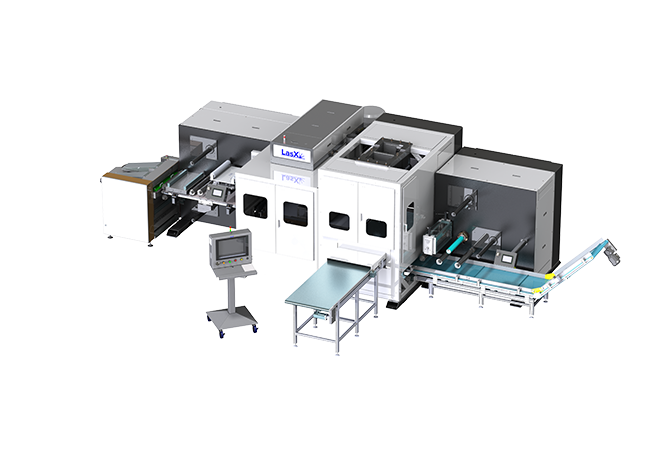The digital carton sector is showing strong growth. Cutting and finishing short run carton work is a challenge to existing workflows, but several manufactures are meeting the demand. By Neel Madsen.
Laser engineering specialist LasX showed its LaserSharp technology with integrated robotic functionality at the PackExpo show in Chicago. By combining laser cutting with robotics, the company has extended the digital workflow to include pick and place functionality. Adding robotic arms for material handling allow the finished parts to be removed from the waste then separated, stacked and counted in a single process. This is done inline by using the same data that drives the laser, which registers to a printed 2D barcodes in the margin of the substrate. Job parameters for both the laser and robot are contained in a single working file and can be changed on the fly.
‘Digital print has a tendency to float, which is why we register to a barcode,’ explained vice president of business development Dave Pung. ‘Our Instant Order Change feature allows the laser to follow this barcode for perfect registration, so there is no waste and we can offer orders of one.’ He added, ‘By stacking the product ready for the customer at the point of converting, we have eliminated a number of downstream steps. Shipping the exact right amount is always difficult, but this technology combines several processes and cuts out a lot of waste and time.’
The company has been integrating robots for eight years, gaining experience in a number of sectors beyond labels and packaging. The new machine shown at PackExpo is the SRTP (sheet/roll-to-part) model, which was converting folding cartons, showcasing both the power of laser cutting, with its capabilities of added intricate scoring and cutting patterns, and the advantages of robotics.
Kama’s die-cutters now come with a job manager tool that receives all available job data from the pre-press department such as the print PDF, number of sheets, substrate and tools, which it saves together with the machine settings. The Job Manager then calculates the SBU settings and optimum foil feed before sending the information to the machine. During the job it gathers all data, which can be sent to a management information system in real time. The complete job data will then be available for repeat orders. Between the customer’s central network and the Kama machines a workstation will provide data exchange. This computer runs the new Job Manager software and comes with the CPX or Cockpit, and the integration is done through the customer’s own MIS.
The company describes the DC 76 Foil ASB machine as ideal for short-run folding carton production as it offers creasing, embossing, Braille embossing, perforating, hot foil stamping, and combined hot foil stamping and embossing (relief). Taking it further, options include holograms and a module for hot cutting and creasing of plastic materials.
Highcon has upgraded the consumables offering for its digital cutting and creasing machines. In response to its customers’ demands, the majority of who produce short to medium run lengths where set-up time is critical to productivity, the company has developed two new consumables lines, the DART Premium and DART Economy.
The digitally driven rule shape and dimensions can now be adapted automatically, and if necessary, by grain direction, depending on the application or substrate thickness. The Premium range for run lengths up to 50,000 sheets offers foils that can be reused up to five times, faster writing of rules, a wide substrate gamut (paper or folding carton up to 600 microns and corrugated on Euclid IIIC up to 3mm). The Economy range is suitable for short runs up to 5000 sheets of max 450 microns and is for single use only.
Yariv Ben-Yosef, vice president for customer success, said, ‘These new consumables packages are a great demonstration of how our collaboration with our customers leads to new products, tailored to their success.’






